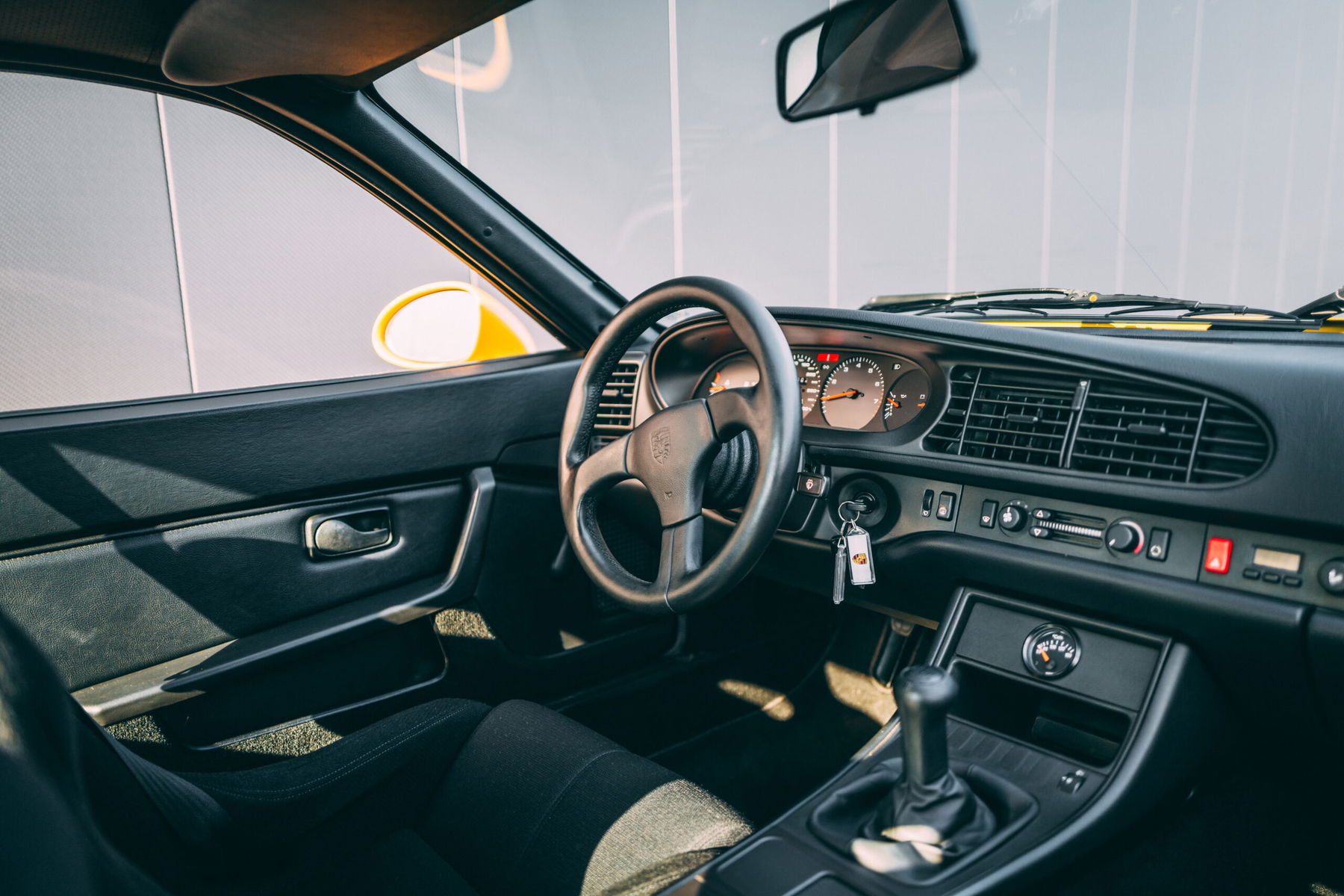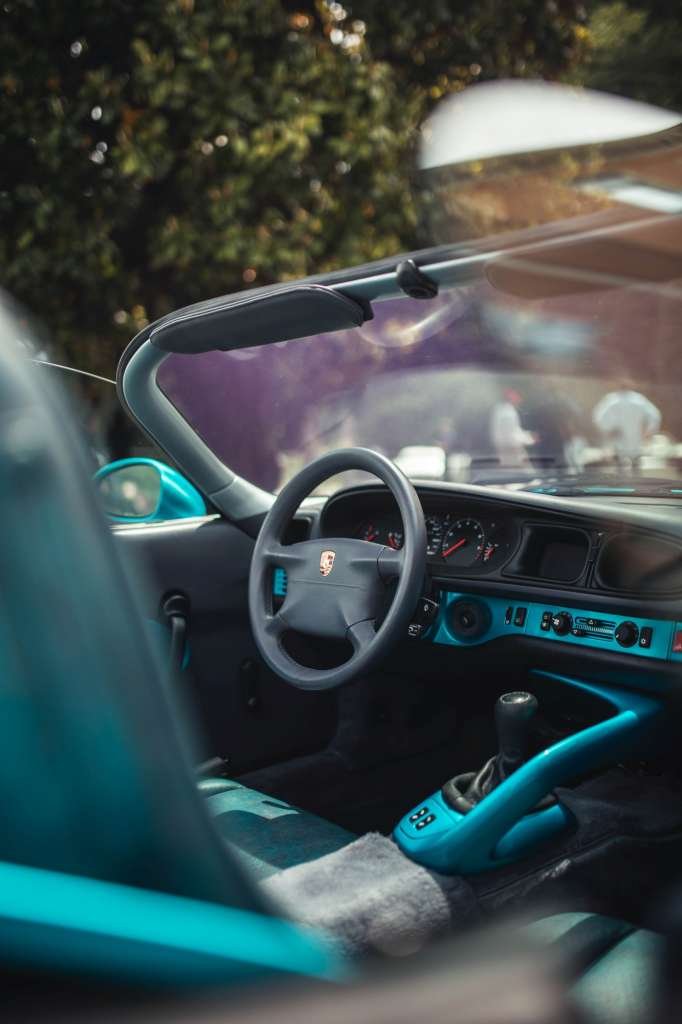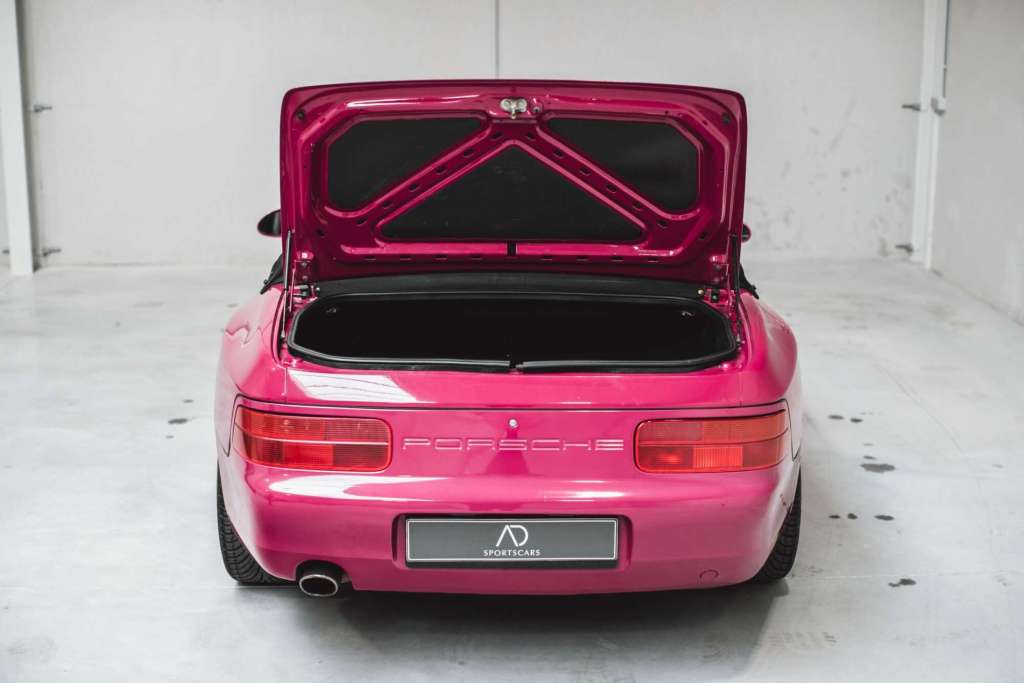
For the 1992 model year, the Porsche 968 was Porsche’s last attempt to conquer the sports car market with a four-cylinder transaxle. In contrast to its predecessor, the Porsche 944, however, it led a shadowy existence. Unjustly, in our opinion. The Porsche 968’s qualities are obvious – outstanding torque, great handling, extremely high manufacturing quality and high reliability. In the Elferspot Porsche 968 buyer’s guide, we tell you what you should look out for when buying one of the final Porsche transaxles.
After the 944 had been on the market for almost a decade, Porsche wanted to launch a new entry-level model in the early 1990s. The coffers in Zuffenhausen were not well filled at the time. Porsche therefore decided to revise the basic design of the 944 once again. As a result, the silhouettes of the Porsche 944 and 968 are very similar. However, the design team led by Harm Lagaay gave the 968 a new front end. It emphasizes the relationship to the 928 and anticipates the later design of the 993.



Porsche offered the 968 as a coupé and convertible right from the start. Both body variants were available with either a 6-speed manual transmission or a 4-speed Tiptronic. The Porsche 968 CS (Club Sport) was added from model year 1993. Production ended in 1995. The 968 did not receive a successor. This is also due to the very low sales figures. The literature mentions figures ranging from just over 11,000 to almost 13,000. The Porsche 968 Owner’s Club speaks of 11,763 units.
Either way, the Porsche 968 is by far the rarest transaxle model from Zuffenhausen. By comparison, over 160,000 units of the Porsche 944 were sold. Nevertheless, it has found a special place in the hearts of many Porsche fans. It is individual and ultimately the most carefully polished front-engined sports car from Zuffenhausen.
When people talk about the Porsche 968, it’s definitely not due to notorious rust problems. Because the last transaxle is exemplary when it comes to rust prevention. Its body is hot-dip galvanized and the cavities are factory-preserved. Nevertheless, a look behind the grille of the B-pillar does no harm. If there is rust there, it will be expensive. Incorrectly positioned jacks are also a common cause of damage and corrosion. Otherwise, there are no typical rust spots, as long as the object of desire is accident-free.




This is because accident damage to the Porsche 968 carries a certain risk. Once the sheet metal parts are deformed, the galvanizing is usually damaged. This leads to corrosion over time. In addition, sheet metal damage to the 968 is very expensive to repair. Even a minor collision quickly adds up to an economic total loss. The availability of parts, for example mudguards, can also become a problem.
Typical transaxle: The bonding of the rear window frame can come loose. This is caused by UV radiation and sometimes too strong gas struts. The result is a leaking rear window and consequently a wet trunk. It is therefore essential to lift the trunk carpet and take a close look.
You can also tell inside the Porsche 968 that this is the final development stage of the transaxle-era. Although it is largely a refreshed Porsche 944 S2 interior, the workmanship is of the highest standard. Hardly any other sports car, and in general hardly any other car from this era, can cope with high mileage as well as a Porsche 968, even in the interior.
The Porsche 968 interior is high-quality and a real eye-catcher, especially in extroverted colors. © David Fierlinger, Elferspot
Nothing should squeak or rattle. The noise level in the 968 – with the exception of the significantly lightened Clubsport versions – is still easily suitable for everyday use. Unlike its predecessors, it also has no major problems with cracked dashboards. With more unusual colors, however, the availability of spare parts is not always guaranteed. This is not yet a major problem with the gear knob, for example, but it is with storage compartments and armrests. Many parts are only available new in standard colors.
For all its quality and solidity, the Porsche 968 remains a car that is now more than three decades old. It is therefore important to check all electrical features. This is because it sometimes happens, for example, that power window switches do not work. Any lifting roof should also be checked. Small things such as buzzing speakers or broken dimmer switches for the instrument lighting can lead to lengthy troubleshooting. The same applies to poor radio reception – the cause is often chafing in the cable to the roof aerial.

If the air conditioning system does not work, it can also be expensive. Although condensers and compressors are still available, they can easily add up to four-figure sums with installation and filling. Another potential annoyance can be the rear window heater. Even with apparently intact plugs, the heating wires in the windshield itself can become brittle.
The Porsche 968’s engine was based on that of the Porsche 944 S2. From a displacement of 2,990 cm³, the M44/43 now produced 240 hp at 6,200 rpm and 305 Nm at 4,100 rpm. In other words, 29 hp and 25 Nm more than its predecessor. This was achieved by reducing the camshaft’s weight, use of lighter connecting rods and pistons, larger intake valves, an increase in compression ratio to 11:1 and the first use of VarioCam technology. This system, patented by Porsche, hydraulically adjusts the camshaft profile. It thus ensures a fuller torque curve.

This VarioCam is one of the critical points, though. Oil leaks can occur at the solenoid valves due to worn O-rings. The slide rails of the VarioCam chain tensioner also wear out over the years. If they have never been replaced, this should be done immediately. And while you’re at it, be sure to take a look at the camshafts! The teeth of the camshaft sprocket can break. If a tooth is missing or excessive wear is visible, the corresponding camshaft should be repaired immediately (if still possible) or replaced.
With good care, a Porsche 968 engine can withstand very high mileages of well over 300,000 kilometers.
The oil pan gasket, valve cover gasket, crankshaft seal, balancer shaft seals and oil filter housing should also be checked for leaks. If the engine vibrates noticeably, especially when idling, it is probably time for new engine mounts. The M44 should almost run as smoothly as a six-cylinder engine. If it has a lumpy idle and doesn’t run smoothly, this may be due to incorrectly fitted balancer shafts. Otherwise, the engines of the M44 family are robust fellows. With good care, a Porsche 968 engine can withstand very high mileages of well over 300,000 kilometers. The prerequisite for this is of course (also) regular timing belt replacement.
However, the advantages of the transaxle concept – such as the very balanced weight distribution – come at a price. The drivetrain is more complex due to the rear-mounted gearbox. If you hear whining/grinding noises coming from the rear, you need to be particularly careful. Both the 6-speed manual gearbox and the 4-speed Tiptronic have their pitfalls.
Both the 6-speed manual gearbox and the 4-speed Tiptronic are allergic to imbalance in the transaxle tube. If the differential seems noisy, countermeasures should not be put on the back burner. © David Fierlinger, Elferspot
The bevel/disc gear of the differential can break. The transmission bearings themselves (for example on the transmission input shaft) also wear out over time. If a bearing replacement is necessary, a comprehensive overhaul with synchronizer rings is recommended. Fixing transmission leaks is often more expensive than expected. If there is an unusual amount of play on the gearshift or the gear changes generally feel imprecise, a newly welded bolt on the gearshift works wonders.
The transaxle shaft, which connects the engine to the transmission, also needs attention from time to time. Worn bearings in it cause noticeable vibrations and noises from the middle of the car. They are strongest in manual gearboxes around 4,200 rpm and in Tiptronic gearboxes around 3,300 rpm. But an overhaul alone is not enough. Correct assembly is hardly possible without the appropriate special tools. If the shaft is not brought back into position with absolute precision, the expensive overhaul is quickly wasted.


Vibrations and banging in the drivetrain can also indicate a defective dual mass flywheel. A good test for this: Start off without accelerating when the engine is warm. Noticeable rattling when the engine is switched off is also an indication. If the flywheel needs to be replaced, an upgrade has proven its worth. The 964 Carrera RS single-mass flywheel fits plug and play and, depending on the version, saves up to ten kilograms. The result: significantly faster revving, with a slightly less smooth idle. Another good part on that front: Unlike its predecessors, it is relatively easy to change the clutch through a service flap.
The Porsche 968 also shows no signs of more than normal wear on the suspension. Front axle shuddering is mostly due to stabilizer links or strut bearings. Its extremely effective brake system is also considered to be very durable. Shock absorbers should be added to the purchase price if not explicitly mentioned as new. An upgrade to a modern suspension setup raises the driving experience in the 968 to a significantly higher level.
In general, the list of model-specific weaknesses remains pleasingly short. The Porsche 968 is rightly regarded as one of the best-finished Porsche sports cars ever. This high standard of quality can also be felt in its handling. It is so well-balanced and objectively good that critics sometimes misunderstand it as boring.



Unfortunately, the high quality of workmanship, coupled with relatively low production numbers, also comes at a price. In comparison, the cars themselves are (still) among the more affordable Porsche sports cars. However, maintenance should not be underestimated. Replacing brake discs and pads alone can quickly eat up 2,000 euros. Regular timing belt changes – recommended every four, at the latest six years or 80,000 kilometers (100,000 km from MY ’93) – are also a cost driver.
Getting sluggish window regulators moving again is also labor-intensive and therefore expensive. Door and window seals are more than 30 years old and are becoming cracked or brittle. The piping between the body parts (for example on the rear bumper) shrinks over the years and can only be replaced. In addition, repairs to the handbrake, replacement of suspension bearings and the elimination of oil leaks are labour-intensive. Specific Porsche 968 parts are generally not on the cheap side and not always easy to obtain.
At 1,440 and 1,470 kilograms respectively, the Cabriolet is exactly 70 kilograms heavier than the Coupé. The 968 CS, on the other hand, is 50 kilograms lighter than the Coupé and weighs in at 1,320 kilograms. The longitudinal dynamics, on the other hand, hardly differ. All three variants are specified with a top speed of 252 km/h.
At 6.5 seconds from 0 to 100 km/h, the acceleration figures are also the same. The Tiptronic version is significantly slower at 7.9 seconds. It tends not to be recommended for sporty drivers. This is because the shifting processes of the 4-speed gearbox are not particularly quick and rather comfort-oriented from today’s perspective. We are deliberately excluding the extremely rare turbo models at this point. They are too special and play in completely different price leagues.



So what are the differences between the Porsche 968 Coupé and Cabriolet? Primarily in the driving experience. Logically, the Cabriolet does not have the same rigidity as the Coupé. Combined with the slightly higher weight and more body roll it feels more like a cruiser. By today’s standards, however, even as a coupé the 968 has a relatively high body roll in fast corners. The wind noise in the convertible is obviously louder than in the coupé due to the fabric top.
968 convertibles also have significantly less utility value. The Coupé’s large luggage compartment (over 500 liters with the rear seats folded down) is only sufficient for flat luggage in the Cabrio at 225 liters. The 968 Coupé is therefore the vehicle of choice for Porsche newcomers who also want to use their vehicle for everyday driving. Thanks to its slim dimensions, still contemporary performance and exemplary fuel consumption figures, the Porsche 968 is one of the best everyday classics available.



When deciding between the Porsche 968 and 968 CS, the intended use case is clearly important. The CS is generally regarded as a front-engined GT3 – and not without reason. It has 50 kg less weight than the 968 and also has the limited slip differential, which is virtually indispensable for sporty drivers, on board as standard. The bucket seats familiar from the 964 Carrera RS were available as an optional extra. Airbags were also only available as an option.
Neither rear seats, central locking nor electric windows were available. Rear loudspeakers, engine compartment lighting, electric tailgate release and electrically adjustable exterior mirrors also fell victim to the diet. However, due to the significantly reduced battery capacity and the reduced payload of 250 kg, the CS is only suitable for everyday use within certain limitations.
Its versatility makes the Porsche 968 a Swiss army knife of sports cars. It is still fast. Its handling encourages sporty driving and the chassis meets the highest demands. Its utility value and fuel consumption figures are also impressive. And it is a little bit better than the Porsche 944 in every single respect, while its performance figures are almost on a par with the 964 Carrera.
In this respect, it seems doubly surprising that it was unable to match the commercial success of its predecessor. However, due to the costly addition of the VarioCam and the general production standard, the 968 is no bargain when it comes to purchase and maintenance. Even within the brand, the Porsche 968 is a car for individualists.
For those who are not put off by the higher costs compared to the 944 and at the same time want the more exclusive vehicle, it is an excellent choice. And, provided it is looked after properly, it is also a very sustainable one with a potentially long future.
Of course, prospective buyers are always concerned with the question “Will the Porsche 968 increase in value?”. Since 2019, prices for the Porsche 968 Coupé and Convertible have remained relatively stable. Tiptronic models are on average a few thousand euros cheaper. The Porsche 968 Club Sport, on the other hand, has increased in value by almost 15 percent between 2019 and 2022. This trend could continue. The demand for reduced, purist sports cars is unbroken.
“Hardly any other sports car manages to be as good as the 968 in so many disciplines.”
Richard Lindhorst, Elferspot
However, the Porsche 968 is not a good choice for speculators. And that’s a good thing. Because the qualities of the last transaxle are so sublime that it still deserves a place on the roads of today. Despite its market launch more than three decades ago, the Porsche 968 is not old news. It is therefore advisable to savor the Porsche 968 at every available opportunity. Thanks to its balance, it is also perfectly at home on racetracks and is particularly beginner-friendly. It is just as suitable as an unobtrusive grand tourer with plenty of torque. Hardly any other sports car manages to be as good as the 968 in so many disciplines.
© Titelbild: David Fierlinger, Elferspot
Elferspot magazine